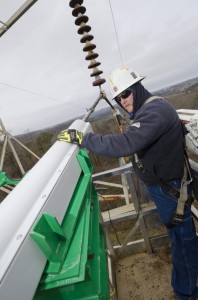San Francisco-based Smart Wire Grid, a provider of smart grid devices designed to control power flows on transmission lines, got $13.4 million in a Series B round of venture funding on March 12, 2014, from RiverVest Venture Partners and a second undisclosed investor. This is a partial close funding targeting a total of $18.39 million for the round, according to the SEC filing. The company was founded in 2010.
The U.S. Department of Energy’s ARPA-E provided Smart Wire Grid with initial funding to the tune of nearly $4 million in October 2012.

Smart Wire Grid’s devices are designed to work existing transmission lines by clamping onto them and controlling the flow of power to provide more consistent control over how energy is routed within the grid on a real-time basis. This directly addresses concerns regarding the grid’s inability to effectively store intermittent energy from renewables for later use.
At the recent Cleantech Innovation Summit, ARPA-E Director Cheryl Martin described Smart Wire Grid as a success story. “We funded them to do the initial development as well as a first test,” she said. The first test involved 99 Smart Wire Grid devices along a 17-tower stretch in East Knoxville, Tenn., and was successful. The devices have since been tested several times in Southern California. Smart Wire Grid is “in negotiations with potential customers, outside the U.S., as well,” she said noting the company offers a “very, very innovative solution in a small package.”
ARPA-E’s website noted that Smart Wire Grid’s development of a solution to control power flow within the electric grid would enable utilities to “better manage unused and overall transmission capacity.” According to the agency: Due to congestion and inefficiencies, 300,000 miles of high-voltage transmission lines in the U.S. today can provide only half the transmission capacity at any given time. “Increased consumer demand should be met in part with a more efficient and economical power flow,” ARPA-E noted, adding that Smart Wire Grid’s power flow control devices could increase overall grid transmission utilization by more than 30% and result in cost savings of over 50% when compared with simply upgrading transmission lines themselves.